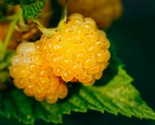FREE SHIPPING 25+ seeds Salmonberry - Fruit bearing shrub - {RUBUS spectabilis}
Shipping options
Estimated to arrive by Thu, Aug 28th.
Details
This estimate is based on:
- The seller's handling time
- USPS Ground Advantage (1 to 10 business days) transit time to US
Actual delivery times may vary.
Have shipping questions? Contact the seller
FREE via USPS Ground Advantage (1 to 10 business days) to United States
Return policy
Replacement product available within 30 days
Payment options
PayPal accepted
PayPal Credit accepted
Venmo accepted
PayPal, MasterCard, Visa, Discover, and American Express accepted
Maestro accepted
Amazon Pay accepted
Nuvei accepted
Shipping options
Estimated to arrive by Thu, Aug 28th.
Details
This estimate is based on:
- The seller's handling time
- USPS Ground Advantage (1 to 10 business days) transit time to US
Actual delivery times may vary.
Have shipping questions? Contact the seller
FREE via USPS Ground Advantage (1 to 10 business days) to United States
Return policy
Replacement product available within 30 days
Payment options
PayPal accepted
PayPal Credit accepted
Venmo accepted
PayPal, MasterCard, Visa, Discover, and American Express accepted
Maestro accepted
Amazon Pay accepted
Nuvei accepted
Item traits
| Category: |
Seeds & Bulbs
|
| Quantity Available: |
111 in stock
|
| Condition: |
New
|
| Sunlight: |
Partial Shade
|
| Season of Interest: |
Summer
|
| Watering: |
Medium
|
| Soil pH: |
Neutral
|
| Brand: |
Unbranded
|
Listing details
|
Seller policies:
|
View seller policies
|
|
Shipping discount:
|
Seller pays shipping for this item.
|
|
Posted for sale:
|
More than a week ago
|
|
Item number:
|
1586721901
|
Salmonberry fruit bearing Purple flowering shrub {RUBUS spectabilis} 25+ seeds | Medicinal | Free Shipping!
purity: 99%
germination rate: 91%
Rubus, derived from ruber, a latin word for red, is the genus of plants generally
called brambles. The epithet spectabilis means spectacular due to Salmonberry’s
showy flowers and fruits. The common name Salmonberry is thought to have come from
the natives’ fondness for eating the berries with salmon roe, but it could also be
due to the orangy-pink color of the berries.
Distribution:
Salmonberry is found from southern Alaska to the northern California coast; mostly
on the western slope of the Cascades-but it can be found in areas of eastern B.C. and northern Idaho.
Growth:
This species grows to 12 feet (4m) from branching rhizomes, forming dense thickets.
Habitat:
It grows in the dappled shade of moist woods and along streambanks.
Wetland designation: FAC+, Facultative, it is equally likely to occur in wetlands
or non-wetlands.
Salmonberry berry Diagnostic Characters:
The arching stems of Salmonberry have golden-brown,
shedding bark, similar to Pacific Ninebark. Salmonberry stems, although largely unarmed,
can range from having scattered prickles to being very bristly. Smaller twigs zigzag slightly
from node to node. Leaves have 3 sharply toothed leaflets, the lateral ones smaller and sometimes
unequally lobed or divided. Five-petalled flowers are a striking pink to reddish-purple.
The fruits are raspberry-like with a hollow core, ranging from yellow to orange-red.
In the landscape:
Although it has attractive flowers and fruits, Salmonberry is best delegated
to the wild garden due to its prickly, thicket-forming habit. It is a great choice for wetland
restoration projects.
Salmonberry flowerPhenology: Bloom time: April-May. Fruit ripens: May-July.
Propagation: Stratify seeds warm for 90 days then cold at 40º F (4º C) for 90 days.
Scarification of the seed with sulfuric acid or sodium hyperchlorite prior to stratification
may improve germination rates. Salmonberry is easily propagated by cuttings, layering or division.
Remaining stumps or underground rhizomes quickly resprout new growth after a fire or other disturbance.
Use by People: Salmonberries, being one of the earliest berries to ripen, were one of the
most important foods for natives. The berries are too watery to dry, so were usually eaten
fresh in oolichan grease or with salmon or salmon eggs. Reports vary on the berries’ flavor
from “insipid” or “inferior” to “juicy with a very good flavor” or “tasty.” It is likely that
differences in taste are due to variations within the species or the relative ripeness of each berry.
Today the berries are sometimes made into jams, jellies, candy, or wine. Young sprouts were also an
important food for natives in early spring and summer; they were peeled, eaten raw or steamed.
Preparations of the bark were used on wounds, especially burns.
